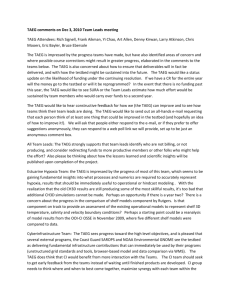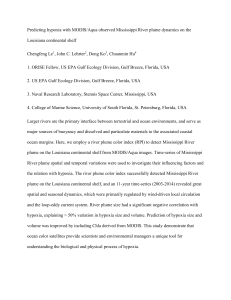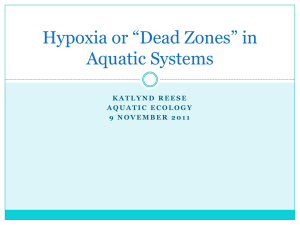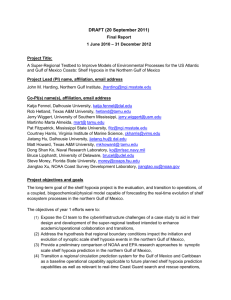Shelf Hypoxia Kickoff Meeting Notes
advertisement
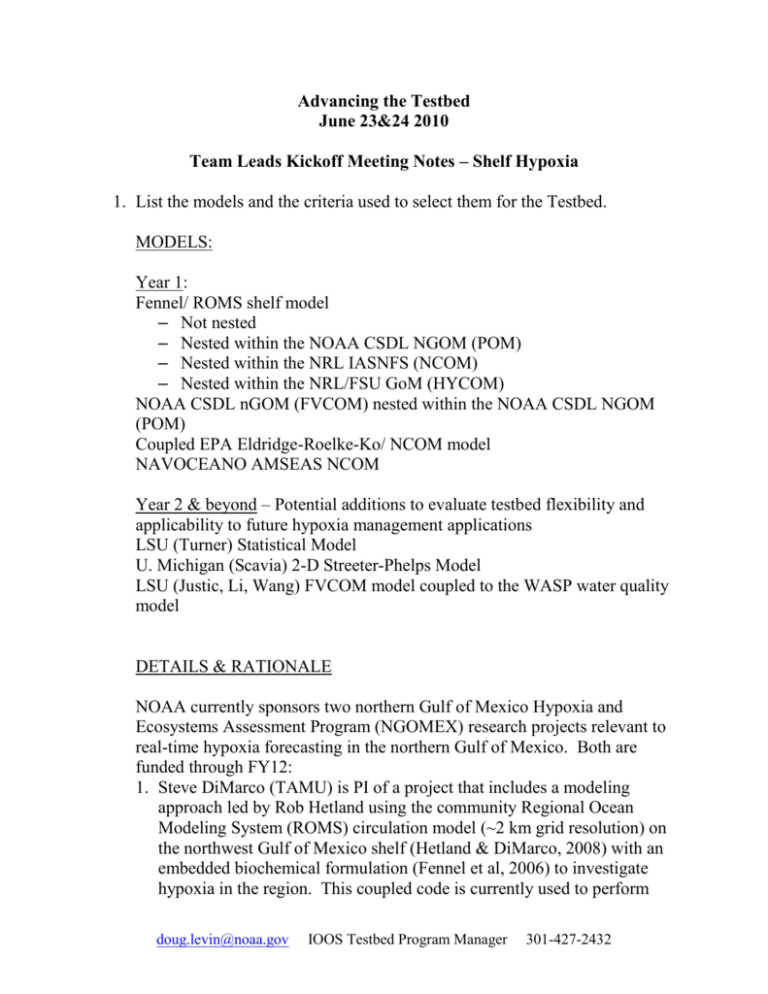
Advancing the Testbed June 23&24 2010 Team Leads Kickoff Meeting Notes – Shelf Hypoxia 1. List the models and the criteria used to select them for the Testbed. MODELS: Year 1: Fennel/ ROMS shelf model – Not nested – Nested within the NOAA CSDL NGOM (POM) – Nested within the NRL IASNFS (NCOM) – Nested within the NRL/FSU GoM (HYCOM) NOAA CSDL nGOM (FVCOM) nested within the NOAA CSDL NGOM (POM) Coupled EPA Eldridge-Roelke-Ko/ NCOM model NAVOCEANO AMSEAS NCOM Year 2 & beyond – Potential additions to evaluate testbed flexibility and applicability to future hypoxia management applications LSU (Turner) Statistical Model U. Michigan (Scavia) 2-D Streeter-Phelps Model LSU (Justic, Li, Wang) FVCOM model coupled to the WASP water quality model DETAILS & RATIONALE NOAA currently sponsors two northern Gulf of Mexico Hypoxia and Ecosystems Assessment Program (NGOMEX) research projects relevant to real-time hypoxia forecasting in the northern Gulf of Mexico. Both are funded through FY12: 1. Steve DiMarco (TAMU) is PI of a project that includes a modeling approach led by Rob Hetland using the community Regional Ocean Modeling System (ROMS) circulation model (~2 km grid resolution) on the northwest Gulf of Mexico shelf (Hetland & DiMarco, 2008) with an embedded biochemical formulation (Fennel et al, 2006) to investigate hypoxia in the region. This coupled code is currently used to perform doug.levin@noaa.gov IOOS Testbed Program Manager 301-427-2432 hindcast experiments to understand the development and evolution of the dead zone on the Texas and Louisiana shelf. 2. Nancy Rabalais (LUMCON) leads a project also targeting the northern Gulf large hypoxic zone that includes refinement and extending the capabilities of 2 forecast models that have been the basis of NOAA Dead Zone forecasts that are used to inform the interagency Gulf Hypoxia Task Force of the validity of targeting nutrient reductions for hypoxia mitigation. These models are: a. A statistical (simple regression) model led by Gene Turner (LSU), and b. A 2-D Streeter-Phelps Model led by Don Scavia (U. Michigan) A major goal of these two NGOMEX projects is to integrate results and modeling tools to develop an ensemble of forecast models to improve quantitative understanding of causative relationships between regulatory factors (e.g. nutrient loads) and hypoxic zone size. Both of these projects will meet regularly to coordinate findings and approaches with the goal to synergistically advance overall management outcomes. This approach is consistent with the modeling testbed concept, and inclusion of models from both projects strengthens the justification for the present and longer-term SURA effort, and its next steps toward management application. Dubravko Justic is leading a multi-sponsor project that has implemented the FVCOM model for the Louisiana–Texas shelf (FVCOM-LATEX) with more recent coupling to the WASP water quality model in order to develop quantitative predictions of hypoxic zone dynamics. The Environmental Prediction Agency currently sponsors research at the Naval Research Laboratory (NRL) to implement a biochemical capability (Morse & Eldridge, 2007; Roelke et al, 1999) in the NRL-developed 2 km northern Gulf Naval Coastal Ocean Model (NCOM) (http://www7320.nrlssc.navy.mil/IASNFS_WWW/EPANFS_WWW/EPAN FS.html). Unlike the shelf-only ROMS effort noted above, the northern Gulf NCOM is nested within a larger 5 km NCOM, the quasi-operational1 “Quasi-operational” denotes a real-time system running in a research or developmental mode. “Pre-operational” implies a nowcast/forecast capability, planned for operations, running in realtime, having undergone extensive developmental evaluation but yet to undergo its final technical evaluation by the operational entity. “Operational” denotes a federal agency (e.g., NAVO for the U.S. Navy, Center for Operational Oceanographic Products and Services for NOAA) is 1 doug.levin@noaa.gov IOOS Testbed Program Manager 301-427-2432 IntraAmerica Seas Nowcast/Forecast System (IASNFS) covering the Gulf of Mexico and Caribbean (http://www7320.nrlssc.navy.mil/IASNFS_WWW/; Ko et al,, 2003), itself nested within the Naval Oceanographic Office (NAVO) 14 km operational global application of NCOM (Martin, 2000; Barron et al, 2004; Barron et al, 2006). NAVO currently provides real-time subsets of the global NCOM output to the NOAA NCEP Operational Prediction Center as well as the NOAA NGI/ NCDDC developmental Ocean NOMADS data server for distribution. NRL, in its role as primary development and transition agent for the operational NAVO, recently transitioned an 8 km global, pre-operational HYCOM capability. This is planned to replace the existing operational global NCOM in a year or so (Bub, NAVO, personal communication). NRL also runs a quasi-operational 4 km Gulf of Mexico HYCOM (Prasad & Hogan, 2007) nowcast/ forecast system that can serve as a surrogate for planned next generation operational implementations of a 4 km global HYCOM. NRL has also transitioned a relocateable (Relo) NCOM to NAVO allow rapid implementation of a new nested region into a pre-operational phase (Ko et al, 2007). Once an area passes its subsequent operational evaluation it becomes operational and available for distribution. Existing operational 3 km Relo NCOM areas include implementations for the U.S. East Coast, Southern California, and Hawaii. NAVO plans to implement a preoperational 3 km Relo NCOM for the Gulf of Mexico/Caribbean (Gom/Car) in June 2010 providing access to the fields on the NGI/ NCDDC OceanNOMADS server. This is roughly comparable to the NRL IASNFS with the notable 2 km resolution difference as well as the use of the multivariate optimal interpolation used in the NAVO version (Frank Bub, NAVO, personal communication). The NOAA Coastal Survey Development Laboratory (CSDL) develops coastal modeling capabilities destined for transition to and operational implementation by the NOAA Center for Operational Oceanographic Products and Services (CO-OPS). Current Gulf of Mexico transition planning includes incorporating a biochemical formulation into a northern Gulf nGOM (an FVCOM circulation model) on the shelf itself nested within responsible for maintaining a configuration managed, rigorously evaluated code providing realtime, output to users. doug.levin@noaa.gov IOOS Testbed Program Manager 301-427-2432 the larger quasi-operational CSDL, 5 km Gulf of Mexico NGOM (a Princeton Ocean Model nowcast/forecast system). Two potential future alternative boundary conditions for the nGOM include the NAVO, 3 km GoM/Car Relo NCOM once it becomes operational and also the next generation 4 km global HYCOM (Patchen, NOAA CSDL, personal communication) 2. List the metrics you will use to test these Models. HYDRO HINDCAST COMPARISON (Time Period 2004-2009) Temperature, salinity, currents and stratification via: -Profile comparisons (Consider profile to profile gradients to avoid single profile issues) -Drifter comparisons -ADCP comparisons Potential Tools: -NAVOCEANO (MAVE & PAVE) -Model Analysis Viewing Environment -Profile Analysis Viewing Environment -NOAA CSDL tools - Time series, water level, currents, T & S at fixed locations - -series of statistics associated - - view stratification Other: - Bias vs. Variance Target Diagrams? - Taylor diagrams? - RPSEA tools Efficiency metrics ( e.g. speed,…) HYPOXIA HINDCAST COMPARISON doug.levin@noaa.gov IOOS Testbed Program Manager 301-427-2432 Given the current R&D status of hypoxia forecasting, operational tools for hypoxia evaluation are not available. Hypoxia evaluation metrics under consideration : shelf-wide temperature, salinity and oxygen distributions. - Histograms (Rob has done this for salinity, could be done for other variables as well) Plume size and position has been shown to be a dominant controlling factor in the size and extent of bottom hypoxia in the northern Gulf of Mexico. - Areal extent of predefined salinity classes, e.g. 20<sal<25, etc. (very useful for comparing between models and years, maybe less so for comparing with data) - Need: Relate back to historical metrics of areal extent for management continuity Integral measurements of water properties, such as the volume of water contained within the 33 psu isohaline (used by the Minerals Management Service as an operational boundary for the Mississippi/Atchafalaya River plume system) or the areal extent of hypoxia. Exploration of a new hypoxia metric, namely, a map of residence time of surface water on the shelf that may be useful for inter-model comparison. Additional metrics: - RMS, correlation coefficient ,fronts where appropriate (e.g. satellite chl), bias AMSEAS EVALUATION -Profile comparisons -Drifter/ glider comparisons -Met buoy comparisons -Met scatterometer comparisons doug.levin@noaa.gov IOOS Testbed Program Manager 301-427-2432 3. What quantitative methods will be used to define Baseline Performance? See item 2 above. 4. What methods/techniques will be used to enhance model performance? This will be refined during the kickoff meeting sessions. We hypothesize that coupling the shelf hypoxia model to candidate basin models representing the larger scale dynamics of the Gulf will enhance the performance of both the shelf physical model as well as its coupled hypoxia component. Not considered year 1 important priority 5. What quantitative methods will be used to compare the enhanced method to the baseline calculation? See item 2 above. 6. What enhancements will be integrated into the model to aid in its transition to an Operational Center? We expect that the coupling of the shelf to basin model will provide improved performance for any eventual out-year transition of the hypoxia model to operations. For the NAVOCEANO AMSEAS transition sub-task, the model is preconfigured from NAVOCEANO and is only to be evaluated for its readiness to progress from pre-operations to operations. Expect that outyear CI design includes: additional data avai;lable for NOAA data tanks, ESMF, and standardized formats (e.g. HDF5/ netcdf4) Note that ROMS on path for ESMF. This project will provide guidance for needed data sets, model to model linkages, wave coupling, … 7. What methods/techniques will be used to calculate the Impact of the changes on model transition to the Operational Centers? Not applicable to Year 1 project. doug.levin@noaa.gov IOOS Testbed Program Manager 301-427-2432 8. How will interoperability between the models be measured? Weird question Doug. Never mind Not applicable to Year 1 project but will be considered at kickoff meeting sessions primarily in shelf to basin coupling aspects. 9. What tangible deliverables will your team produce by the end of Year 1? See attached Excel spread sheet. Tangible deliverables are listed for each Shelf Hypoxia sub-project as a task in bold blue font. Reports on Subtasks 1,2,& 3 as well an operational AMSEAS at NAVOCEANO -Suite of models and products accessable via the SURA server Use different boundary conditions and atmospheric forcing -Provide example demonstration of model suite in action by investigating shelf hypoxia drivers 10.Identify the role and responsibility for each of your team members See attached Excel spread sheet. Roles and responsibilities are listed for each team member. 11.Develop a calendar for biweekly sitreps to be delivered to Executive Team (IOOS, SURA, & TAEG) and monthly concalls to the ET. SURA Proposed Progress Monitoring Calendar Situation Reports to Team Leads by 2nd Thursday of Month. (Start July 15*) Team Lead Situation Reports to EC by 3rd Thursday of Month (Start July 22*) Report Out to Project Team on 4th Thursday of Month (Tue for Nov & Dec) *For July, reporting will take place on the 3rd , 4th & 5th Thursdays doug.levin@noaa.gov IOOS Testbed Program Manager 301-427-2432
